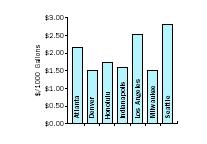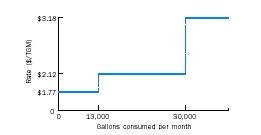Pricing, Water
An acquaintance once said that "every water faucet in New York City leaks." She was exaggerating, of course, but her point was that New Yorkers do not take the time or spend the money to repair leaks. Why? Most residents of the city pay a flat fee for their water. For a fixed monthly charge, residents can use as much water as they want. Marginal cost is zero. Hence, the wasted water costs them nothing, aside from the annoyance of listening to the drip.
But why should anyone worry about the cost of water? The figure shows recent prices of an additional 1,000 gallons per month in several U.S. cities in 2001, ranging from $1.25 to nearly $3.00. (Water rates in other countries often are considerably higher.) For most Americans, this is a very small part of their budgets. Even so, study after study has shown that most water users will indeed respond to a higher price by fixing leaks, using a broom instead of a hose to clean the driveway, and otherwise conserving water. Imposing a quantity charge, or raising it, forces users to rethink, even if only informally, their marginal benefit/marginal cost computations and adjust consumption accordingly.

What is Water's True Cost?
Even when water utilities use a quantity charge instead of a fixed fee, they often set the quantity charge too low. Typical public water utilities design their rates to cover out-of-pocket costs, but such costs often fall short of the true economic value of extracting and distributing water.
Subsidies.
First, governments often subsidize water infrastructure . Developers often must contribute ready-to-use water systems to the utility. These subsidies do not come directly from the utility company and hence do not show up in their accounting records.
Capital Equipment.
Second, capital equipment—pumps, water mains, buildings, and so on—is a major element of total water cost and tends to last for several decades. Replacing a water main built, for example, 40 years ago would cost almost six times the original cost because of inflation alone. Yet few if any utilities update the value of aging capital equipment when they add up costs.
Scarcity Value.
Third, water in the ground or in a stream is valuable because it is scarce. The right to divert water from a stream or to pump it from an aquifer is an asset of growing value to utility companies but again is often ignored in standard accounting practice. One study estimated scarcity value to be at least as large as all other conventionally reckoned costs together. Similarly, any environmental costs incurred in providing public water supplies should be added to water rates.
Pricing as a Conservation Incentive
For the reasons outlined above, water rate schedules based on the utility's out-of-pocket costs leave consumers paying less than they should. And since consumers pay too little, they use too much.
However, an increasing number of water utilities have recognized the potential of pricing to provide an incentive for their customers to conserve water. Some (Seattle, Washington and southern California, for example) have refined the notion, charging higher rates during droughts or in dry seasons or for unexpectedly large quantities.
But if water is priced at its full economic cost, what about the poor? Several major cities have taken at least tentative steps toward establishing what is called an "inclined-block" water rate schedule, as shown here:

Trending Toward Demand Management.
On average, Americans use more than 1,000 gallons of water per day. The amount necessary to sustain life processes is quite small, perhaps a few gallons per day. Of the difference, how much is really needed for bathing, laundry, housecleaning, car washing, lawn and garden care, filling the swimming pool, and so on? Clearly, if consumers are presented with the right incentive, they can conserve on water use.
This article has considered mainly residential water users, but similar considerations apply to businesses and farms that use water. Farmers, for example, have developed highly sophisticated means of conservation by determining exactly how much water each plant needs and applying just that amount, but adjusting for water costs. Hotels install low-flow showerheads and toilets. Car washes and many other businesses reuse water.
Most public utilities and other water-supply agencies try to accommodate growth in water demand by looking for additional water sources to develop; this is supply-side management. But growth can often be met by conservation in the use of existing sources; this is demand management. Some utilities go so far as to charge a premium during the dry season, for unanticipated high water demands, or during periods of drought. Pricing is a powerful tool of growing importance in the toolkits of water managers and environmentalists.
SEE ALSO Conservation, Water ; Demand Management ; Markets, Water ; Utility Management .
James E. T. Moncur
Bibliography
Gardner, B. Delworth. "Water Pricing and Rent Seeking in California Agriculture." In Water Rights: Scarce Resource Allocation, Bureaucracy, and the Environment. Terry L. Anderson, ed. San Francisco, CA: Pacific Institute for Public Policy Research, 1983.
Howe, Charles W., and F. P. Linaweaver. "The Impact of Price on Residential Water Demand and Its Relation to System Design and Price Structure." Water Resources Research 3 (1967):12–32.
Moncur, James E. T., and Richard L. Pollock. "Accounting Induced Distortions in Public Enterprise Pricing." Water Resources Research 32, no. 11 (November 1996): 3355–3360.
——. "Scarcity Value for Water: A Valuation and Pricing Model." Land Economics 64, no.1 (February 1988):62–72.
Internet Resources
"Estimated Use of Water in the United States in 1995." U.S. Geological Survey. <http://water.usgs.gov/watuse/pdf1995/html> .
EFFECTS OF SUBSIDIES
As anyone who has seen the 1939 film Gone with the Wind knows, cotton was once the staple crop of the southern United States. No more. Cotton, a very waterintensive crop, was well suited to the southern climate with its heavy rainfall. The center of cotton production has since shifted, however, to bone-dry parts of California. Why?
Several reasons exist for cotton's western migration, but clearly this shift could not have happened without federally funded irrigation projects. Generally, farmers who use water from these projects pay far less than its full economic value; they are thus subsidized. Subsidies are common among government-financed water resource projects. However, they are not free: taxpayers bear the cost in proportion to their tax payments.